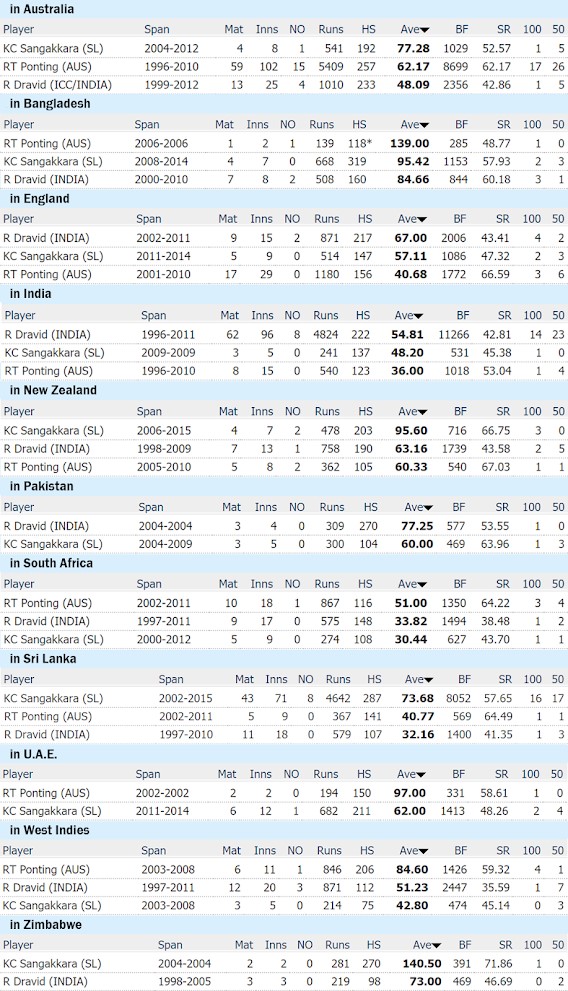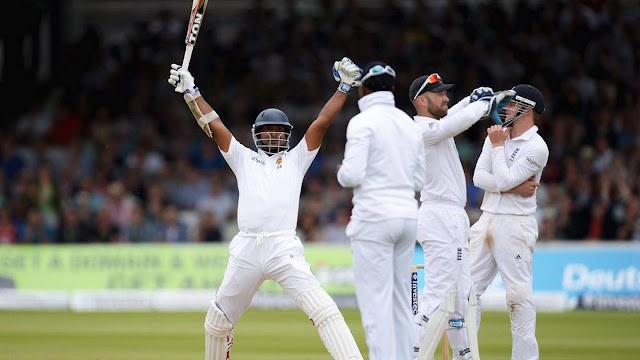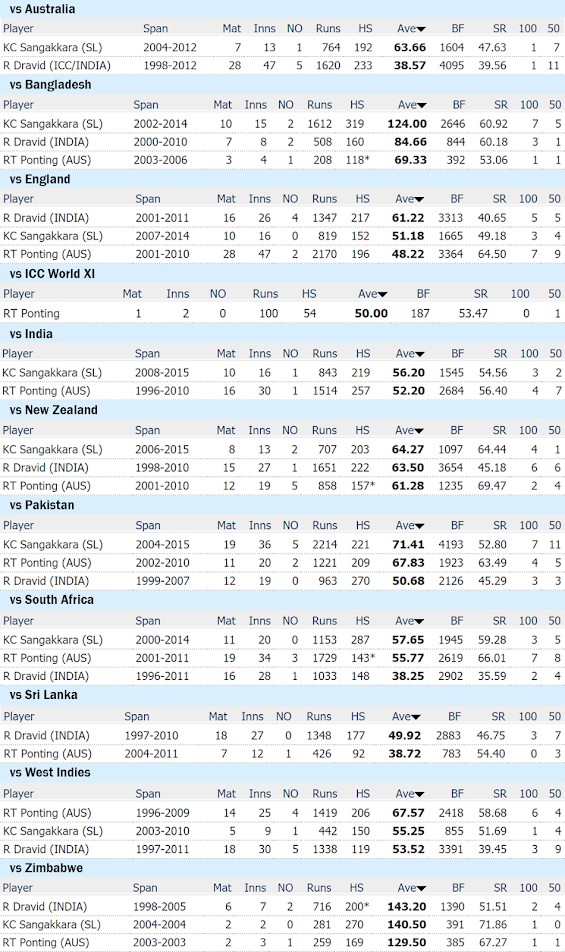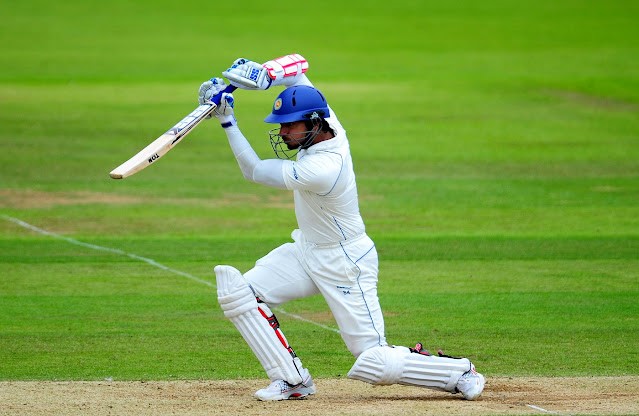One of the most vital batting positions in the game is the No. 3 spot, the backbone of every batting line-up. Throughout the history of the game, we have seen some great No. 3 batters, who have shouldered the weight of their teams.
Among those greats, Don Bradman is undoubtedly the best batter Test cricket has ever produced and that also makes him the best No. 3 batter in history. But who is the best No. 3 after him? This is a comparison between Kumar Sangakkara, Ricky Ponting, and Rahul Dravid, who many consider to be the finest No. 3s after Bradman.
Sangakkara used to be known as a really classy and stylish batter with brilliant technique. For the first 6 years of his Test career, he played as a wicket-keeper batter. He then went on to a completely different level after giving up the gloves.
Ponting is arguably one of the finest batters to have played the game. For the first 6 years of his Test career, he mostly batted at No. 6. But he became a run machine as a result of being promoted to the No. 3 position.
Dravid is someone who has shown his patience while batting, which helped his team on many occasions. He is known to be the ‘Wall’ because of his tight defense.
Omitting some all-time greats for various reasons
The reason for omitting the likes of Brian Lara, Sir Viv Richards, and Wally Hammond from this argument is that they didn’t bat much at No. 3 compared to this trio. Despite the fact that the three of them belong to three different eras, they scored just over 3000 runs at No. 3, which just isn’t enough to put them alongside Sangakkara, Ponting, and Dravid in the same bracket as No. 3 batters.
In the longer format, Lara’s regular batting position was No. 4, where he scored thousands of runs. Although Richards is arguably one of the greatest batters in history, it is impossible to consider him as a No. 3 as he played equally in both the No. 3 and No. 5 positions. Hammond, a legendary English batter from a different era, also batted equally at No. 3 and No. 4, so the same logic applies to Hammond as well. Apart from them, the modern-day great Steve Smith has also batted mostly at No. 4.
Regardless of the difference between the eras, having a yardstick is a must, so if we consider a batter with just over 3,000 runs in the relevant batting position, it would be unfair to someone who has almost triple the number of runs another one has scored. Therefore, in my opinion, it is essential to have at least 5000 runs in the relevant batting position, especially when it comes to such a conclusion across eras.
Let’s get back to the comparison of the three who played in the same era. Below is a comprehensive comparison of Sangakkara, Ponting, and Dravid in Tests based on 14 different criteria. (I have sorted all the figures by their batting average)
- Overall figures
This is one of the key factors that basically reveals to us how they performed at No. 3 throughout their careers.

- Performance only as specialist batters
Test is a longer format where the wicket-keeper is the only person who needs to be present throughout the match. Therefore, batting in a responsible batting position like No. 3 is putting extra pressure on a wicketkeeper. If the batting side bats for a whole 2/3 days, the keeper would be too tire and as a result, most wicket-keepers usually bat at no.6/7 in Test matches.
The numbers below indicate the batting performance, without the wicketkeeping gloves on. Among the three, Sangakkara is the only batter who has played as a wicket-keeper while batting at No. 3.

*From here onwards I will exclude all the runs scored by them as designated wicket-keepers considering what I have explained under the second point above. Accordingly, all the statistics under each criterion are filtered only from the runs scored by them as specialist batters.
- Performance against top 7 opponents
Let’s have a look at their numbers against top cricketing nations excluding Bangladesh and Zimbabwe.
There is a controversy among some people that Sangakkara boosted his overall career average by managing high averages against those two weak opponents and he is nothing without them. But you can see from the figures below on how inaccurate that is.

Sangakkara still averages 61.43 even without his performance against those two teams as a specialist batter.
- Performance in different conditions
Adapting to all kinds of different conditions is a hallmark feature of a top-class batter and that comes to the fore when it comes to performances away from the comforts of home conditions, in unfamiliar situations.
4.1 Outside home (Away and neutral)
Here are the statistics outside home where the real test of a player’s character, grit, and resolve comes to the fore.

4.2 Figures by each country
Let us go deeper and check how they performed in each of the host countries.

Here we see that Ponting has struggled in India. On the other hand, both Sangakkara and Dravid faced the biggest blips in their careers whenever they toured South Africa, managing averages of just 30.44 and 33.82 respectively.
It is surprising to see an Asian batter like Rahul Dravid fail in Sri Lanka where conditions aren’t unfamiliar to him. He averaged just 32.16 there.
However, with the exception of the few countries where the trio failed, they managed a batting average of over 40 in all other host countries. One thing to note here is that Ponting never batted at No. 3 when he played in Pakistan and Zimbabwe.
In terms of positives, in England, India, and Pakistan, Dravid is fabulous and his numbers reflect that quite clearly. Considering their performance in South Africa and West Indies, Ponting sails over the other two quite comfortably. But in Australia, New Zealand, and Sri Lanka Sangakkara has an edge in terms of average. Though all three of them have not played too many innings in New Zealand, Sangakkara has been just prolific each time he has stepped out there.

Ponting has played merely 2 innings in the United Arab Emirates whereas Dravid has never played and therefore there is not much to compare between the two. But Sangakkara played 12 innings there and was very successful even though it is less than the average of Ponting who played just 2 innings.
When we look at the number of innings played in each country, it is quite obvious that Sangakkara has played fewer innings in some countries than the other two. But we must note that the number of matches the players get to play is not something they can control. Because we all know that Australia and India play more Test matches than Sri Lanka.
Thus, the only country where Sangakkara could not perform is South Africa. Also, Ponting failed only in India. Beyond that, after scrutinizing the statistics of those two, Sangakkara fares marginally better in terms of average and is a bit ahead of Ponting here.
- Performance against each opponent
Being able to perform against all opposition teams is a superior ability of a dominant batter. Let’s see who among these has been the most successful in performing against every opponent.
By the way, there is an argument, which works in favor of Sangakkara and Dravid, the fact that they faced the formidable Australian bowling attack, unanimously considered the greatest bowlers of that era.
Nearly half of that era was dominated by Australia and facing their bowling attack with the likes of McGrath, Gillespie, Lee, and Warne was a huge challenge for the batters at the time. But Ponting avoided facing those bowlers as they belonged to his own team.

Ponting, on the other hand, averaged 38.72 against Sri Lanka, which is the only opponent he has failed against. With the exception of England and Sri Lanka, he has an average of over 50 against all the rest of the opponents.
Despite the fact I mentioned above about that Australian bowling attack, look at Sangakkara’s phenomenal numbers against every opponent. These figures reveal that he is the only one to manage an average of over 50 against all opponents.
- Who batted the most on the hardest tracks?
In general, batters play most of their careers in their home conditions. So, one of the key considerations in this comparison is how favorable those home conditions are to the batters, as batting on the hardest tracks and being successful is a superior ability to consider someone as a versatile batter. Let’s first look at the figures of the home conditions in which the three of them played the most.


Although all the batters who played in Sri Lanka had a mediocre average (average runs per wicket) of 33.29 during the aforementioned period from 2000 to 2015, Sangakkara alone stands out with his astonishing batting average of 73.68. This shows that Sangakkara was the man who had to play the most in his career in Sri Lanka, which had the hardest tracks to bat among these host countries.
- Scores of 50 or more
The ability to build long innings consistently is a key criterion, especially when it comes to the longer format. This gives us a fair idea of how often they were able to convert the innings they played into long innings.

Sangakkara’s excellence is evident in the fact that he has converted almost half of his innings into scores of 50 or more.
- Contribution in wins and draws
A huge factor that helps in categorizing a player as a game-changer or merely very good is their performance in winning causes or helping their side secure draws. This is another important criterion regarding a player’s ability to change a result of a game.

- Contribution in the second innings (3rd or 4th innings of the match)
While the first two innings of a Test match are generally considered the best for batting, the last two innings (2nd innings of a batter) are completely different and it’s the hardest part of the game progressing. That second innings performance usually differentiates the true greats from the mediocre players.

Despite that fact, even here Sangakkara managed an average of nearly 60, while Ponting and Dravid managed only 46.60 and 43.62 averages respectively.
Furthermore, Sangakkara has the highest average among the trio when a team chases a target over 350 in the 4th innings.
- Player-of-the-match awards
Even though it’s a team game, we have seen some exceptional individual performances that have permitted players to single-handedly turn games. These standout performances have also been highlighted with those match-winning players getting a special mention at the end of the game with the player-of-the-match award.

But look at the number of matches Sangakkara has played to win them compared to the other two. This is how he comes to the fore even by this criterion.
- Some non-statistical factors
So far, I have been comparing them from various aspects with priority given to statistics. But the argument of who the best No. 3 batter after Bradman is cannot be resolved purely on statistics.
The impact they have made on the team, their ability to dominate bowlers, the way they shouldered the burden of their teams, the technique, ability to play under any game situation, especially during pressure scenarios also needs to be taken into consideration. However, comparing them to each other by such aspects is somewhat impractical as all three have equally succeeded in the above-mentioned skills.

In hindsight, one cannot overlook the fact that both Sangakkara and Dravid played most of their careers without stable openers in their respective teams, which gets them on the crease earlier than expected on most occasions. Ponting, on the other hand, had one of the greatest opening pairs in Langer and Hayden, who helped relieve the pressure off the No. 3 batman as well as the rest of the teammates.
On digging deeper, factors such as longevity and the difference between eras are also used as criteria in such an argument. But the complexity of this comparison is lessened by the fact that they all have the same longevity and all three belong to the same generation.
- Finest knocks
Most of the innings here are all-time greatest knocks that the three of them made while carrying the team on their shoulders.
Kumar Sangakkara –
- 192 vs Australia at Hobart, 2007
- 230 vs Pakistan at Lahore, 2002
- 156* vs New Zealand at Wellington, 2006
- 147 vs England at Lord’s, 2014
- 287 vs South Africa at Colombo, 2006
Ricky Ponting –
- 257 vs India at Melbourne, 2003
- 156 vs England at Manchester, 2005
- 242 vs India at Adelaide, 2003
- 118* vs Bangladesh at Fatullah, 2006
- 143* vs South Africa at Sydney, 2006
Rahul Dravid –
- 180 vs Australia at Kolkata, 2001
- 233 vs Australia at Adelaide, 2003
- 148 vs England at Headingley, 2002
- 270 vs Pakistan at Rawalpindi, 2004
- 148 vs South Africa at Johannesburg, 1997
The comparison between these three is rather chaotic when it comes to something like big innings. So all three of them had the same ability to score such unparalleled innings, it is a very difficult task to compare each other here even by this factor as they were equally good at this.
- Career records
Below is just a few of the records they have made in their long cricketing careers.
Kumar Sangakkara –
- Fastest to 12000 runs (224 innings)
- 2nd most double centuries (11)
- Highest partnership for the third wicket (624)
- 5th most player-of-the-match awards (16)
Ricky Ponting –
- 2nd most runs in career (13378)
- 2nd fastest to 12000 runs (247 innings)
- 2nd most fifties in career (103)
- 4th most fours in career (1509)
Rahul Dravid –
- 4th most runs in career (13288)
- 2nd fastest to 9000 runs (176)
- 2nd most fours in career (1654)
The well-known fact here is Sangakkara was far superior without his wicket-keeping gloves on. But he reached that fastest 12,000-run milestone, including the number of innings as designated wicket-keeper.
- The recognitions (Awards and inductions)
Some of the legendary players are named for such awards and inductions in recognition of their achievements in the game over the years.
Kumar Sangakkara –
- ICC Men’s Cricketer of the Year (2012)
- ICC Men’s Test Player of the Year (2012)
- Inducted into ICC Cricket Hall of Fame (2021)
- Wisden Leading Cricketer in the World (2011, 2014)
- ICC Men’s Test Team of the Year (2006, 2007, 2008, 2010. 2011, 2012, 2014)
Ricky Ponting –
- ICC Men’s Cricketer of the Year (2006, 2007)
- ICC Men’s Test Player of the Year (2006)
- Inducted into ICC Cricket Hall of Fame (2018)
- Wisden Leading Cricketer in the World (2003)
- ICC Men’s Test Team of the Year (2004, 2005, 2006, 2007)
Rahul Dravid –
- ICC Men’s Cricketer of the Year (2004)
- ICC Men’s Test Player of the Year (2004)
- Inducted into ICC Cricket Hall of Fame (2018)
- ICC Men’s Test Team of the Year (2004, 2006)
Aside from the awards each of the three have won, Sangakkara won multiple awards at the Wisden Leading Cricketer in the World and Ponting won multiple awards at the ICC Men’s Cricketer of the Year. Dravid, on the other hand, has never been named for Wisden’s Award.

In addition to that, the number of times they have been named for the ICC Men’s Test Team of the Year here gives us a rough idea of how consistently they performed throughout their careers. While Ponting and Dravid have been named to that Test team only four and twice respectively, Sangakkara has been named seven times, reflecting his excellence. So even in this case, we can clearly see how Sangakkara is more prominent than the other two.
I have now compared them by 14 different criteria. Despite some of the disadvantages of Sangakkara that I mentioned under some of the above points, he was still able to succeed and his statistics make up some staggering numbers compared to the other two. Considering all the relevant parameters and all other factors related to the argument, we can conclude that Sangakkara is ahead of the other two by some distance.
Quite obviously, all the 14 points I described above reveal how far Sangakkara is ahead of his contemporaries in every aspect. This is how this comprehensive analysis proves that Sangakkara is the best No. 3 batter after Sir Don Bradman in Tests.
*Disclaimer: The views and opinions expressed in this article are those of the author’s and do not necessarily reflect the official policy or position of ThePapare.com.
If you have an opinion on Cricket – you get a Free Hit here. Write to [email protected] to be featured!

















